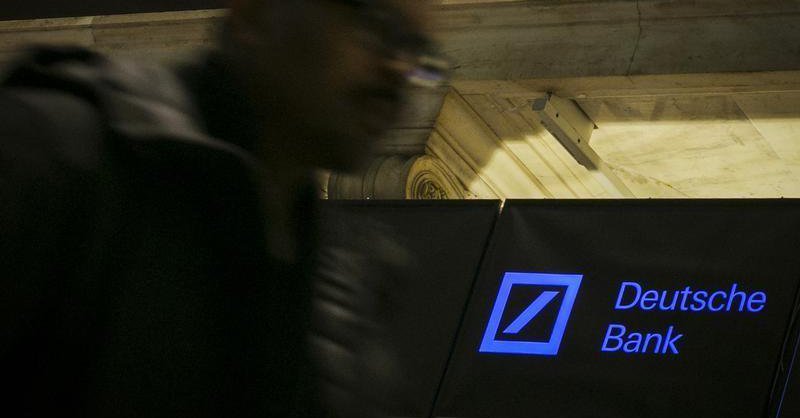
Federal Reserve officials cleared dozens of U.S. banks to boost shareholder payouts after conducting annual stress tests that proved too rigorous, again, for subsidiaries of Deutsche Bank AG and Banco Santander SA.
JPMorgan Chase & Co., Citigroup Inc., Bank of America Corp. and 27 other firms with major U.S. operations passed the exam Wednesday, with many unveiling plans to distribute more capital through dividends and stock buybacks. Even Morgan Stanley, which must shore up internal systems before the Fed issues a final verdict, got conditional permission to boost its dividend 33 percent.
Deutsche Bank Trust Corp. and Santander Holdings USA Inc. were alone in failing, due to "broad and substantial weaknesses across their capital planning processes,” the Fed said. While both had adequate capital and showed improvement after failing last year, their plans still relied on assumptions and analyses that "are not reasonable or appropriate,” the regulator said.
The findings show U.S. banks have largely adapted to the Fed’s stiffer oversight of capital and internal controls in the wake of 2008’s financial crisis. After years spent cleaning up their balance sheets and stumbling in past exams, Citigroup and Bank of America cleared handily this time and are now moving beyond the penny and nickel dividends they’ve been stuck paying. Deutsche Bank and Santander, meantime, both vowed anew to do better next time.
"It took the U.S.-based banks quite a bit of time to get the Fed comfortable,” said David Gibbons, a former bank regulator now at Alvarez & Marsal’s Financial Industry Advisory Services. Some European banks, which haven’t been subject to the test as many years, are still catching up, he said.
Wednesday’s results mark this year’s final round of the stress tests. Last week, an earlier phase -- which didn’t factor in proposed payouts -- found all 33 banks subject to the review have enough capital to absorb losses during a sharp and prolonged economic downturn. For foreign banks, which already have spent billions of dollars trying to meet the Fed’s expectations, the stress tests can determine how much profit a U.S. subsidiary pays to its parent company.
"The capital adequacy of Deutsche Bank Trust Corp. has never been in doubt,” Bill Woodley, deputy chief of the German lender’s Americas business, said in a statement after Wednesday’s results. "We appreciate the Federal Reserve’s recognition of our progress, and we will implement the lessons learned this year in order to strengthen our capital planning process.”
Santander said its unit has devoted staff and resources to improving and that it expects to fare better in 2017.
"Our results confirm that Santander Holdings USA has strong capital levels that are well above the required minimums,” the division’s chief executive officer, Scott Powell, said in a statement. "We have made progress, but our internal capital planning, stress testing, internal controls, governance and oversight require further improvement to meet our regulators’ expectations.”
At Morgan Stanley, the Fed said it found "material weaknesses” in capital planning and that the bank must resubmit its plan by Dec. 29. This year’s submission was the first since Jonathan Pruzan became chief financial officer, succeeding Ruth Porat, who left Wall Street and joined Alphabet Inc.
"They have a new CFO so maybe their handoff, the relay of the baton, didn’t occur as well as expected,” said David Hendler, founder of Viola Risk Advisors and a veteran bank analyst.
Morgan Stanley is committed to addressing the Fed’s concerns and can meet examiners’ requirements, CEO James Gorman said in a statement. Meantime, the firm said it’s increasing the quarterly dividend to 20 cents a share, or 2 cents more than estimated, and plans to repurchase as much as $3.5 billion of stock in the coming four quarters. It’ll also consider redeeming certain capital securities.
The bank’s stock climbed 0.9 percent in extended trading in New York. JPMorgan rose 0.9 percent after saying it will buy back $10.6 billion of stock, up from the $6.4 billion it announced last year. Citigroup gained 2.2 percent after more than tripling its dividend to 16 cents and saying it’ll buy back $8.6 billion of shares.
The Fed’s scenarios were seen as especially tough this year as they called for banks to assume -- in the most severe case -- that U.S. unemployment doubled to 10 percent while the markets tumbled and Treasury yields went negative. The banks would have experienced resulting loan losses of $385 billion, the Fed said last week.
In a lesser "adverse” event, the banks contemplated a minor U.S. recession and mild deflation, while a third was a baseline that tracked the average projections of economists. The scenarios also included some extra hardships for big trading firms, such as Morgan Stanley and Goldman Sachs Group Inc., as they had to assume market shocks and trading-partner woes on top of the other troubles.
Still, even as so many firms passed this year, the review raised concerns among regulators that the biggest U.S. banks need to bolster auditing systems that identify weaknesses in capital planning. The Fed plans to conduct a more thorough review of those operations in the months ahead.
"Buried in the fine print, they are saying there is still more work to be done,” said Michael Alix, a partner at PwC and a former senior official at the Federal Reserve Bank of New York.